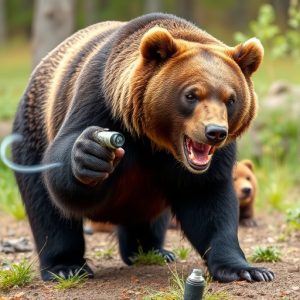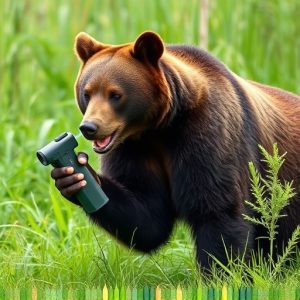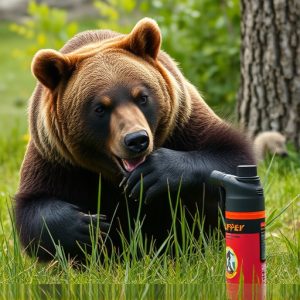Surviving Grizzly Encounters: Wind Direction, Bear Spray Safety & Escape Tactics
Grizzly bears' superior senses make them formidable predators, emphasizing the importance of un…….
Grizzly bears' superior senses make them formidable predators, emphasizing the importance of understanding their behavior for human safety. Key to this is wind direction, as it affects bear spray effectiveness and usage. Positioning yourself downwind reduces your scent detection risk but enhances spray reach when targeting a bear's face and eyes from 20-30 feet away. Bear spray should only be used as a last resort while maintaining a clear escape route.
In the vast wilderness, encounters with charging grizzly bears can be life-threatening. This article equips outdoor enthusiasts and adventurers with essential knowledge to defend against these formidable predators. We delve into understanding bear behavior and their acute senses, guiding you through assessing wind direction for bear spray effectiveness. Learn proper usage and safety tips for this crucial defense mechanism, along with alternative strategies for avoiding and escaping charging grizzlies. Stay safe in the wilderness by mastering these key techniques.
- Understanding Grizzly Bear Behavior and Their Senses
- Assessing Wind Direction for Bear Spray Effectiveness
- Proper Use and Safety Tips for Bear Spray
- Alternative Strategies for Avoiding and Escaping Charging Grizzlies
Understanding Grizzly Bear Behavior and Their Senses
Grizzly bears, known for their formidable strength and agility, are powerful predators with a keen sense of awareness. Understanding their behavior is crucial when navigating potential encounters in the wilderness. These bears have an exceptional sense of smell, hearing, and vision, making them highly efficient hunters. They rely on their senses to detect prey and navigate their environment, especially when foraging for food.
One key aspect to consider is the wind direction. Grizzly bears have a powerful sense of smell, up to 200 times more sensitive than humans, so they can detect potential threats or food sources from far away. When traveling through bear country, staying downwind is generally safer as it makes you less noticeable to them. Bear spray, another important safety measure, is most effective when the wind is blowing in your favor, ensuring its scent doesn’t reach the bear before you deploy it.
Assessing Wind Direction for Bear Spray Effectiveness
When considering bear spray as a defense mechanism, understanding wind direction is crucial for its effectiveness. The key lies in ensuring that the spray reaches the bear and doesn’t blow back onto the user. Generally, it’s advised to face into the wind when deploying bear spray, allowing the aerosolized spray to travel directly towards the bear’s face. This tactic increases the likelihood of disorienting or deterring the charging grizzly, providing a crucial moment for escape.
In terms of safety, knowing the wind direction enables users to stand back at a safe distance and still effectively deploy the spray. Moreover, this knowledge helps in choosing appropriate terrains, such as upwind slopes or areas with natural barriers, that can enhance the spray’s reach and reduce the risk of inhalation by the user.
Proper Use and Safety Tips for Bear Spray
When encountering a grizzly bear, one of the most effective tools in your defense arsenal is bear spray. However, its proper use and understanding of safety tips are crucial for maximizing its effectiveness. Always remember to read the manufacturer’s instructions before using any bear spray.
The wind direction plays a vital role in how successful your bear spray will be. Aim for the bear’s face and eyes, but always keep yourself protected. Never spray directly towards you or into the wind, as it may blow back onto you. Keep an eye on the wind’s direction and ensure that you and your companions are upwind from the bear. This simple step can significantly enhance Bear Spray Safety during an encounter.
Alternative Strategies for Avoiding and Escaping Charging Grizzlies
When faced with an approaching grizzly bear, instinct might push you to run, but this is often counterproductive. Instead, understanding the wind direction becomes crucial for both avoiding and escaping a charging bear. If possible, position yourself upwind, allowing any scent from you to dissipate away from your location. This simple tactic can help prevent the bear from becoming overly agitated or confused by your presence.
In addition to being mindful of the wind, carrying and knowing how to use bear spray is an essential safety measure. Bear spray should be used as a last resort when a grizzly displays aggressive behavior or charges directly towards you. Aim for the bear’s face and eyes from a safe distance, typically around 20-30 feet away, to temporarily stun it and provide an escape opportunity. Always ensure you have a clear path of retreat before deploying bear spray.
When navigating the wilderness, understanding grizzly bear behavior and utilizing strategies like assessing wind direction for optimal bear spray effectiveness are crucial for your safety. Always remember the proper use and safety tips for bear spray, and consider alternative methods to avoid or escape charging grizzlies. By combining these tactics, you can significantly minimize risks when outdoors in bear country. Prioritizing knowledge, preparation, and caution will ensure a safer experience amidst these majestic yet potent creatures.


